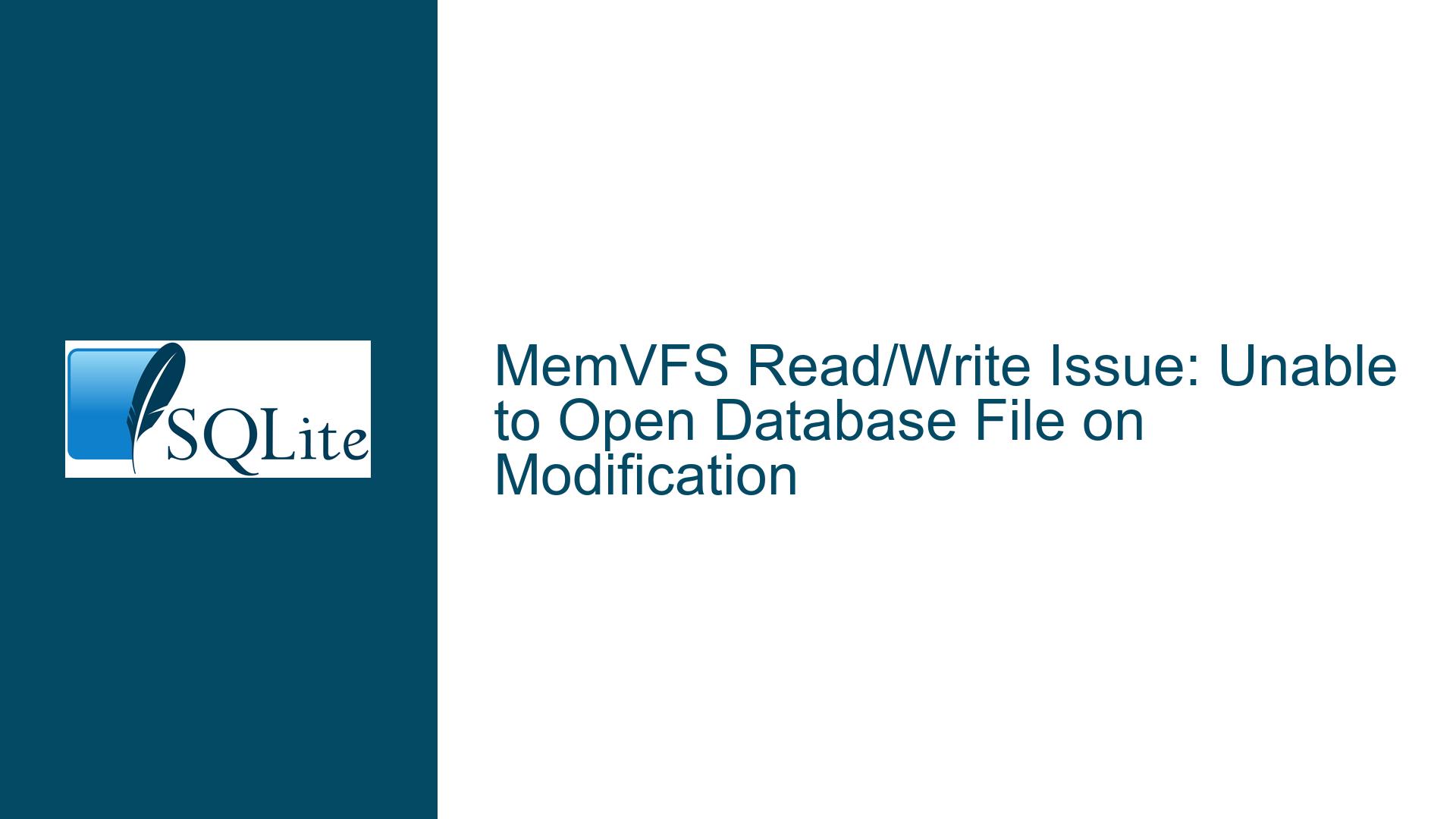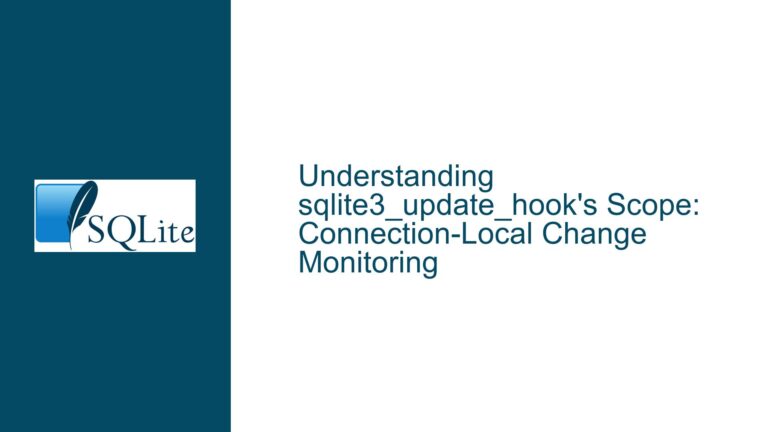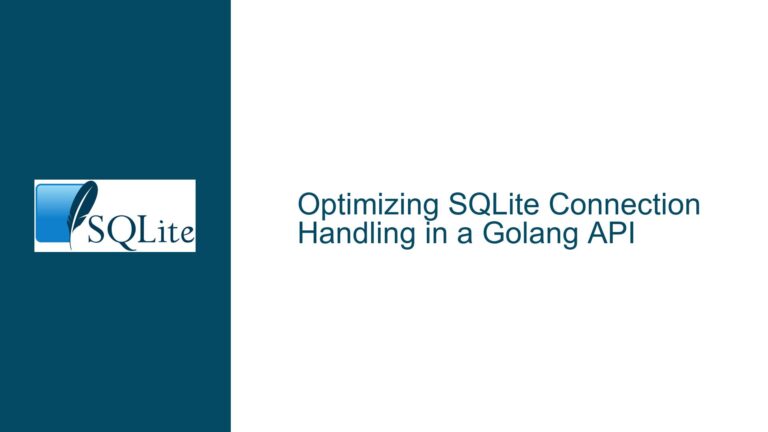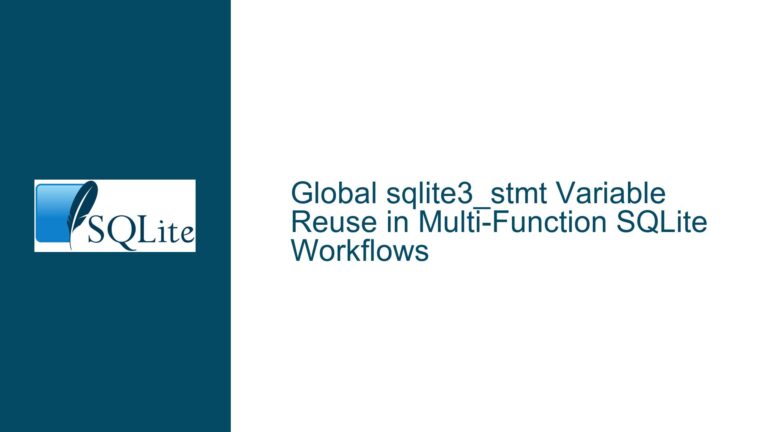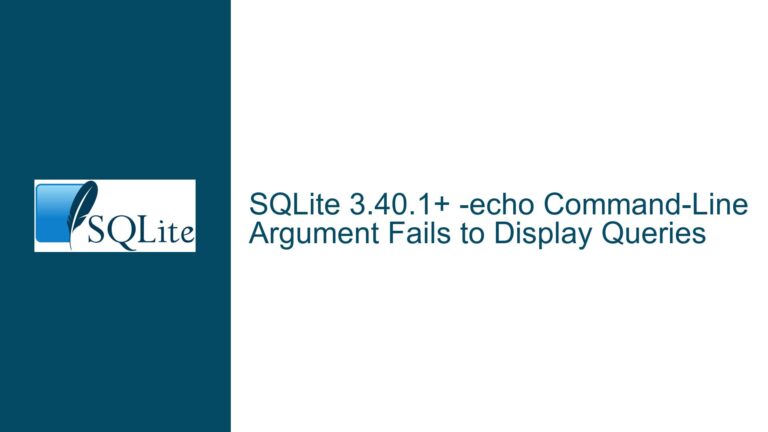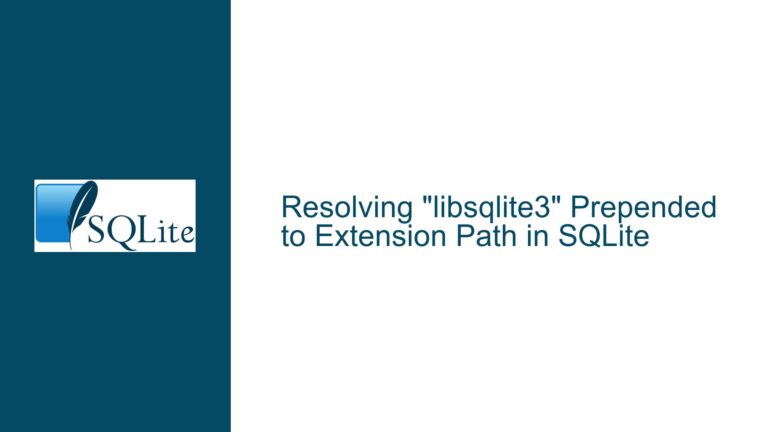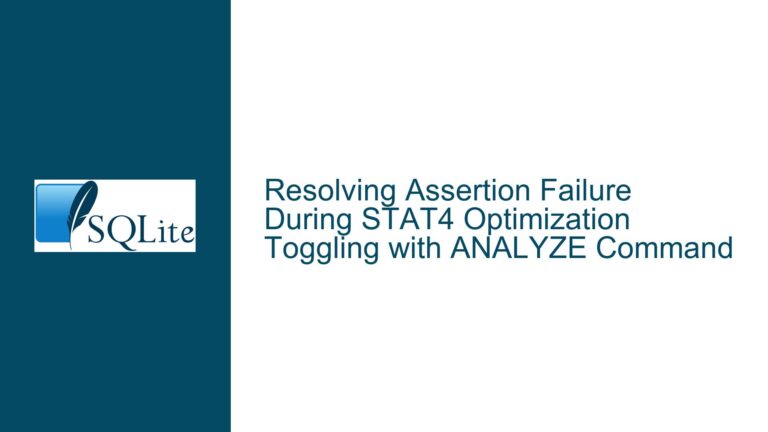MemVFS Read/Write Issue: Unable to Open Database File on Modification
Issue Overview: MemVFS Fails on Database Modification Attempts
The core issue revolves around the inability to modify a database loaded into memory using the SQLite MemVFS extension. The initial setup involves creating a simple SQLite database (foo.db) with a single table (test) and inserting a couple of rows. The database is then read into a memory buffer and opened using the MemVFS extension. While read operations succeed without issue, any attempt to modify the database—such as inserting new rows—results in the error: "unable to open database file."
The MemVFS extension is designed to allow SQLite to operate on databases stored entirely in memory, providing a virtual file system interface. The extension has been explicitly modified to support read/write operations, as evidenced by its commit history. However, the provided C code fails when attempting to write to the in-memory database, despite the read operations functioning correctly.
The problem is not immediately obvious, as the code appears to follow the correct sequence of steps: loading the MemVFS extension, reading the database file into memory, and opening the in-memory database with read/write permissions. The error suggests that the underlying issue lies in how the MemVFS handles write operations or how the memory buffer is managed during these operations.
Possible Causes: Why MemVFS Write Operations Fail
Several factors could contribute to the failure of write operations when using the MemVFS extension. These include issues with memory management, incorrect URI parameters, improper handling of the memory buffer, or limitations within the MemVFS implementation itself.
Memory Management Issues: The memory buffer containing the database is allocated using sqlite3_malloc64, and the freeonclose=1 parameter is included in the URI to ensure the buffer is freed when the database is closed. However, if the memory buffer is not properly aligned or if there are issues with the allocation size, the MemVFS might fail to perform write operations. Additionally, if the memory buffer is not resizable, the MemVFS might not be able to accommodate changes to the database size during write operations.
Incorrect URI Parameters: The URI used to open the in-memory database includes parameters such as ptr, sz, and freeonclose. If any of these parameters are incorrect or improperly formatted, the MemVFS might fail to interpret the memory buffer correctly. For example, if the ptr parameter does not point to a valid memory address or if the sz parameter does not match the actual size of the database, the MemVFS might reject the request.
Improper Handling of the Memory Buffer: The memory buffer is read from a file (foo.db) and passed to the MemVFS. If the buffer is not properly initialized or if there are issues with the file reading process, the MemVFS might fail to recognize the buffer as a valid database. Additionally, if the buffer is modified or corrupted after being passed to the MemVFS, write operations might fail.
Limitations in MemVFS Implementation: While the MemVFS extension has been modified to support read/write operations, there might still be limitations or bugs in the implementation. For example, the MemVFS might not fully support all SQLite features or might have issues with certain types of write operations. Additionally, the MemVFS might not handle concurrent read/write operations correctly, leading to errors when attempting to modify the database.
Troubleshooting Steps, Solutions & Fixes: Resolving MemVFS Write Issues
To resolve the issue of MemVFS failing on database modification attempts, several troubleshooting steps and potential solutions can be explored. These include verifying memory management, checking URI parameters, ensuring proper handling of the memory buffer, and considering alternative approaches such as using the sqlite3_deserialize function.
Verify Memory Management: Ensure that the memory buffer is properly allocated and aligned. Use sqlite3_malloc64 to allocate the buffer and verify that the size matches the actual size of the database file. Additionally, ensure that the freeonclose=1 parameter is correctly specified in the URI to prevent memory leaks.
Check URI Parameters: Double-check the URI parameters used to open the in-memory database. Ensure that the ptr parameter points to a valid memory address and that the sz parameter matches the actual size of the database. If necessary, use debugging tools to verify the values of these parameters at runtime.
Ensure Proper Handling of the Memory Buffer: Verify that the memory buffer is correctly initialized and that there are no issues with the file reading process. Use debugging tools to inspect the contents of the memory buffer and ensure that it matches the contents of the original database file. Additionally, ensure that the buffer is not modified or corrupted after being passed to the MemVFS.
Consider Alternative Approaches: If the MemVFS extension continues to fail on write operations, consider using the sqlite3_deserialize function as an alternative. This function allows you to load a database from a memory buffer into an in-memory database without requiring a custom VFS. The provided alternative code demonstrates how to use sqlite3_deserialize to load the database and perform read/write operations.
Alternative Code Using sqlite3_deserialize:
#include <fcntl.h>
#include <sqlite3.h>
#include <stdio.h>
#include <stdlib.h>
#include <sys/stat.h>
#include <sys/types.h>
#include <unistd.h>
int main(void) {
sqlite3 *db;
char *err;
// Read the real database into memory
int fd = open("foo.db", O_RDONLY);
if (fd < 0) {
perror("open");
return EXIT_FAILURE;
}
struct stat s;
if (fstat(fd, &s) < 0) {
perror("fstat");
return EXIT_FAILURE;
}
void *memdb = sqlite3_malloc64(s.st_size);
if (read(fd, memdb, s.st_size) != s.st_size) {
perror("read");
return EXIT_FAILURE;
}
close(fd);
// Open a memdb database and load the image
if (sqlite3_open_v2("file:/whatever?vfs=memdb", &db, SQLITE_OPEN_READWRITE, NULL) != SQLITE_OK) {
printf("Open failed rc=%d, file='file:/whatever?vfs=memdb'\n", sqlite3_extended_errcode(db));
return EXIT_FAILURE;
}
// Load the database
if (sqlite3_deserialize(db, "main", memdb, s.st_size, s.st_size, SQLITE_DESERIALIZE_RESIZEABLE) != SQLITE_OK) {
printf("Error in deserialize: %d\n", sqlite3_extended_errcode(db));
return EXIT_FAILURE;
}
// Try querying the database to show it works.
sqlite3_stmt *stmt;
// Attempt to mutate the database
if (sqlite3_exec(db, "INSERT INTO test VALUES (3), (4);", 0, 0, &err) != SQLITE_OK) {
fprintf(stderr, "foobar: %s\n", sqlite3_errmsg(db));
sqlite3_close(db);
return EXIT_FAILURE;
}
if (sqlite3_prepare_v2(db, "SELECT b FROM test", -1, &stmt, NULL) != SQLITE_OK) {
fprintf(stderr, "prepare: %s\n", sqlite3_errmsg(db));
sqlite3_close(db);
return EXIT_FAILURE;
}
for (int rc = sqlite3_step(stmt); rc == SQLITE_ROW; rc = sqlite3_step(stmt)) {
printf("%d\n", sqlite3_column_int(stmt, 0));
}
sqlite3_finalize(stmt);
sqlite3_close(db);
printf("Now try opening in memory again...\n");
if (sqlite3_open(":memory:", &db) != SQLITE_OK) {
fprintf(stderr, "open :memory: %s\n", sqlite3_errmsg(db));
return EXIT_FAILURE;
}
if (sqlite3_prepare_v2(db, "SELECT 1", -1, &stmt, NULL) != SQLITE_OK) {
fprintf(stderr, "prepare: %s\n", sqlite3_errmsg(db));
sqlite3_close(db);
return EXIT_FAILURE;
}
for (int rc = sqlite3_step(stmt); rc == SQLITE_ROW; rc = sqlite3_step(stmt)) {
printf("%d\n", sqlite3_column_int(stmt, 0));
}
sqlite3_finalize(stmt);
sqlite3_close(db);
return 0;
}
This alternative approach avoids the potential pitfalls of the MemVFS extension by using SQLite’s built-in sqlite3_deserialize function, which provides a more robust and reliable way to load and modify in-memory databases.
By following these troubleshooting steps and considering the alternative approach, you should be able to resolve the issue of MemVFS failing on database modification attempts. If the problem persists, further investigation into the MemVFS implementation or consultation with the SQLite community may be necessary.
